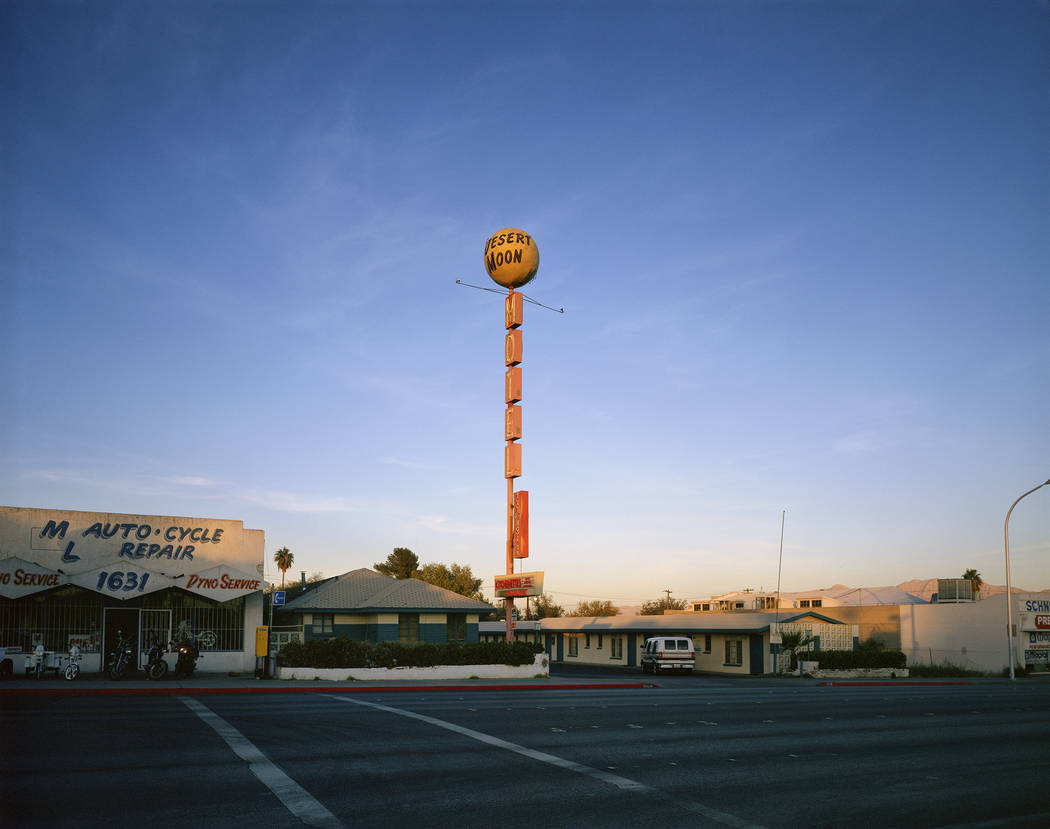‘Motel Vegas’ explores the rise and fall of Las Vegas’ motels — PHOTOS
Their names came from the mythology of the Old West: The El Rancho, the Chief, the Purple Sage, the Desert Moon, the Arrow Head and the straight-shootin’ Old West.
Their names came from the entertainment that lured guests here in the first place: The Par-A-Dice, The Lucky, The Roulette and the Jack Pot.
And while some of their names were straightforward, even mundane (The Travelers, The Vegas), one — the Blue Angel — boldly evoked the ethereal.
All were classic Las Vegas motels and motor courts that in their heyday offered tourists a respite from the road. Most are gone now, their signs flashing perpetual “vacancy,” if they light up at all. But a generation or two ago, they helped create the mythology of the American open road and contributed to Las Vegas’ architectural landscape.
Photographer and art historian Fred Sigman chronicles the rise and fall of some of Las Vegas’ classic motels in his new book, “Motel Vegas” (Small Works Press, $29.99), which features photos that capture the architecture, design, themes and signage of many of the city’s most distinctive motels.
The book also includes essays and archival photos — of postcards and in-room directories and those plastic key fobs that travelers treated as free souvenirs — that recall a time when free TV and air-conditioned comfort were asphalt nirvana to travelers passing through town.
In one essay, Las Vegas historian and historic preservation activist Robert Stoldal notes that at “the height of the golden era of motels — starting after post World War II and ending in the mid-1960s — there were nearly 40 motels on the Strip and more than 180 scattered throughout the Las Vegas Valley.”
Today, he adds, “you can count the number of operating motels on two hands and a couple of toes.”
Sigman, an adjunct professor of art history at the College of Southern Nevada who teaches online from his home in Cambodia and on the road, got his first look at Las Vegas’ motels in August 1968. Sigman was 14 then and had moved here with his attorney father. He recalls that he was more taken then by the ornate signs; his appreciation of motel architecture and design would come many years later.
Sigman graduated from Bishop Gorman High School in 1972 and earned a degree in art history and philosophy from UNLV. He spent about two years as an archivist and photographer for the Las Vegas News Bureau, and his subsequent photographic pursuits have taken him all over the world.
In 1995, Sigman was commissioned to photograph Las Vegas motel signs. Those images were exhibited in New York City in 1997 and in Las Vegas the following year.
Sigman began taking the photos that make up “Motel Vegas” in late 1995. During the yearlong project, all but one of the motels featured in the book were open for, as he writes, “tourists, transients and local residents.”
Motels weren’t unique to Las Vegas, of course, but the city embraced them and their Modern style enthusiastically. As architect and historian Alan Hess writes in the book’s foreword, “the motels in this book have been rode hard and put up wet, but they still tell us how Las Vegas celebrated the Modern spirit more freely, more vividly, more extravagantly than any other city.”
Merely photographing the motels presented unexpected challenges. Sigman writes of his first visit to the Blue Angel Motel — formerly on Fremont Street — with two friends after midnight. After about a half hour of shooting, they were approached by a man who “just seemed to suddenly appear.”
“He asked the usual questions about what we were doing, what kind of camera is that, and who did we work for? … As he kept glancing over his shoulder toward the shadows around the rooms and sidewalks, he suggested that it might not be a good time to be there.
“What we did not realize was that our presence was disrupting business. Customers, sellers and agents retreated into the darkness when we pulled in and set up the camera. The three of us looked at one another and decided to heed his advice … ”
Sigman’s book may evoke a certain nostalgia in readers who hold fond childhood memories of pumping quarters into Magic Fingers bed massagers.
But the motels’ story also involves eventual decline. In the book, Sigman notes that by the time he began the project, motels here housed “people living by a thread” or who were desperately looking for a way to leave Las Vegas and return home.
“I actually stayed in some of these motels. I checked in and got a room and spent the night,” he says. “I used to joke that it was like that Don Knotts movie, ‘The Ghost and Mr. Chicken,’ where he was forced to sleep in a haunted house, and sometimes it actually felt that way.”
“I don’t subscribe to the idea motels give us a nostalgic ride down Memory Lane for the family vacation,” Sigman says. “I can’t deny how individuals see that … but I don’t find them nostalgic at all.”
“When I began looking at the history of motels, sentimentality was never part of the package anyway,” he says. Sigman notes that, even in their heyday, motels “had a very seedy reputation (of) insurance salesmen taking their secretaries to motels. A ‘pillow joint’ is what a lot of them were called in the ’60s, because (guests) can get in and out easily without being noticed.”
Still, Las Vegas’ motels represent a piece of shared history that’s worth remembering. Motels “represent American culture,” Sigman says, and “are surviving elements of that period and everything embedded in that.”
Contact John Przybys at jprzybys@reviewjournal.com or 702-383-0280. Follow @JJPrzybys on Twitter.










































